Priming the base is one of the stages of preparation for subsequent finishing. The liquid helps to harden the surface, make it less porous, and increase adhesion to paint or adhesive. A correctly selected concrete floor primer will speed up the repair, increase the durability of the base, and reduce the cost of consumables.
- The need and benefits of a concrete floor primer
- Varieties of primers by chemical composition
- Acrylic
- Polyurethane
- Epoxy
- Mineral
- Liquid glass
- Varieties of soils according to the principle of action on the base
- Deep penetration
- Impregnating
- Adhesive
- Selection options
- Surface preparation
- Required tools and materials
- Features of applying a primer on a concrete floor with your own hands
The need and benefits of a concrete floor primer
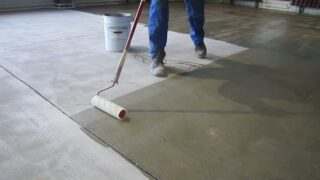
External negative factors often lead to the appearance of defects on the concrete floor, destruction of its top layer. The primer allows you to protect the screed from their influence and improve the adhesion of the floor to the finishing materials. Additional components that make up the composition prevent the development of fungi and mold. The primer has the following advantages:
- The ability to use any material for subsequent floor finishing. Without preparation, the adhesion of the substrate is insufficient for most floor coverings.
- Increased floor life. Moisture or dirt does not penetrate into the concrete, therefore it does not exfoliate, does not crack.
- Increasing the strength characteristics of the base.
- Protection against the negative effects of chemicals.
- Reduced consumption of paint or glue used for decoration.
- Maintaining an optimal moisture level. Due to the clogging of the pores, the concrete does not oversaturate and does not dry out.
In technical rooms, the primer can be used as a finishing floor covering. It seals and waterproofs the floor surface without compromising its appearance.
Varieties of primers by chemical composition
Acrylic
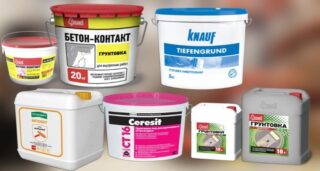
The acrylic-based mixture is water-based, therefore it is well diluted with liquid. It penetrates well into the screed, clogging the pores. Further finishing activities can be carried out within 3-4 hours after processing the base. Acrylic primer does not contain toxic components, improves the adhesion of concrete. It can be used when decorating a children's room, kitchen, bedroom. The tool does not allow the development of fungi, mold. However, the acrylic compound is not suitable for working in rooms with high humidity.
Polyurethane
The primer contains polyurethane components, a solvent, additives that give the liquid various additional properties. It is most often used to treat concrete substrates before painting. It increases the strength characteristics of the floor, is inert to aggressive chemicals, and reduces the consumption of finishing materials. It can be applied even without preliminary dedusting of the surface.
It is allowed to use such a primer for bases equipped with a “warm floor” system. The disadvantage of the material is the long drying time: at least 12 hours. The liquid is quite expensive.
Epoxy
Epoxy concrete floor primer can be used in any room, regardless of its purpose and humidity level. The product is safe for human health, does not have a strong odor, and strengthens the concrete base.The liquid is resistant to the influence of aggressive chemicals, fuels and lubricants. It is allowed to apply the substance on a dry and damp surface. The disadvantage of the material is its short service life. The prepared mixture becomes unusable after 30 minutes.
Mineral
Mineral compositions are made on the basis of cement. These include antiseptics, glue, film-forming agent, moisture protection components. The advantage of the material is fast drying, environmental safety. The disadvantage of a mineral primer is considered to be instability to the influence of aggressive substances.
Liquid glass
Liquid glass is used for priming a concrete base in rooms with high humidity. The product contains sand, silicate, soda. It does not support combustion, repels water. Liquid glass penetrates deep into the concrete layer, strengthening it. However, the working solution sets quickly, and in the finished form quickly loses its technical characteristics.
Varieties of soils according to the principle of action on the base
Deep penetration
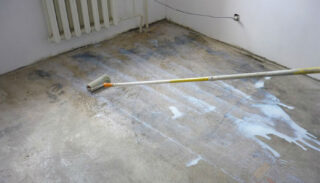
Deep penetration primer suitable for substrates with high porosity. It improves the adhesion of the concrete to the finish. The liquid binds dust well. The components of the solution penetrate deep into the concrete layer and hold the unstable particles together. The layer becomes denser.
Reinforcing compositions contain the maximum amount of adhesive elements. Concrete becomes less free-flowing, does not produce dust. This does not change the color of the base.
Impregnating
Impregnating mixtures are used to treat old concrete floors. They prevent the destruction of the layer, improve its adhesion to finishing materials. The base is getting stronger. The mortars partially clog the pores, leveling the absorbency of the concrete floor.
You can prime the base with such a composition before painting or varnishing it, gluing tiles.
Adhesive
A primer to increase adhesion is applied to a painted or untreated surface. A sticky film forms on the substrate after application. The solution is recommended for poorly absorbent floors.
Selection options
To select a primer for a floor screed, you need to determine in what conditions the base will be used. The following parameters are taken into account:
- an antiseptic must be present in the selected solution: the concrete surface is prone to the accumulation of dampness;
- waterproof compounds are necessary for floors that are intensively used, susceptible to the influence of water, dirt;
- compatibility of the liquid with the finishing material.
When choosing a primer, it is impossible to focus only on its cost. It is better to give preference to solutions with positive reviews. You need to purchase material at certified points of sale in order to avoid buying a fake.
Surface preparation
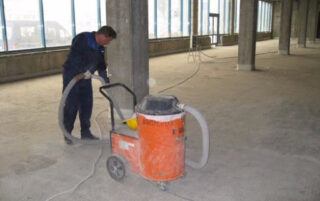
Before applying the primer to the concrete surface, it is necessary to remove all furniture and appliances from the room. The floor covering is removed.
The base is inspected for cracks, chips, exfoliated areas. The fallen off fragments are removed, the bumps and influxes are eliminated.
Despite the fact that most mortars bind dust, it is better to clean the concrete surface with a construction vacuum cleaner. Flaws need to be filled with cement mortar.
Required tools and materials
The primer is applied to the surface of the base with a paint brush or roller. The first option is needed in places where a narrow and thin tool is required. The long nap roller allows a thick layer of protection to be achieved in a short time. It is used if ceramic tiles are chosen as the finish.
The short-haired roller creates a thinner and cleaner layer. The coating is uniform and suitable for subsequent paint application.You will also need a container for the solution.
Features of applying a primer on a concrete floor with your own hands
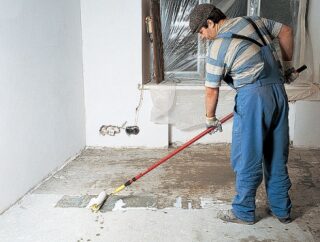
You can apply the primer to the base with your own hands. You need to follow these recommendations:
- special attention is paid to the preparation of the foundation;
- it is better to vacuum the floor before priming with an industrial unit;
- if necessary, the solution is diluted with water (the proportions are indicated on the container with the product);
- apply the composition evenly in several layers (the next one is applied after the previous one has completely dried);
- puddles of the primer must not be allowed to remain on the surface;
- for the soil to be better absorbed, it is necessary to cover the base with a film.
Work should be done in protective clothing, gloves and goggles. The solution adheres quickly to the skin and is very difficult to wash off.








